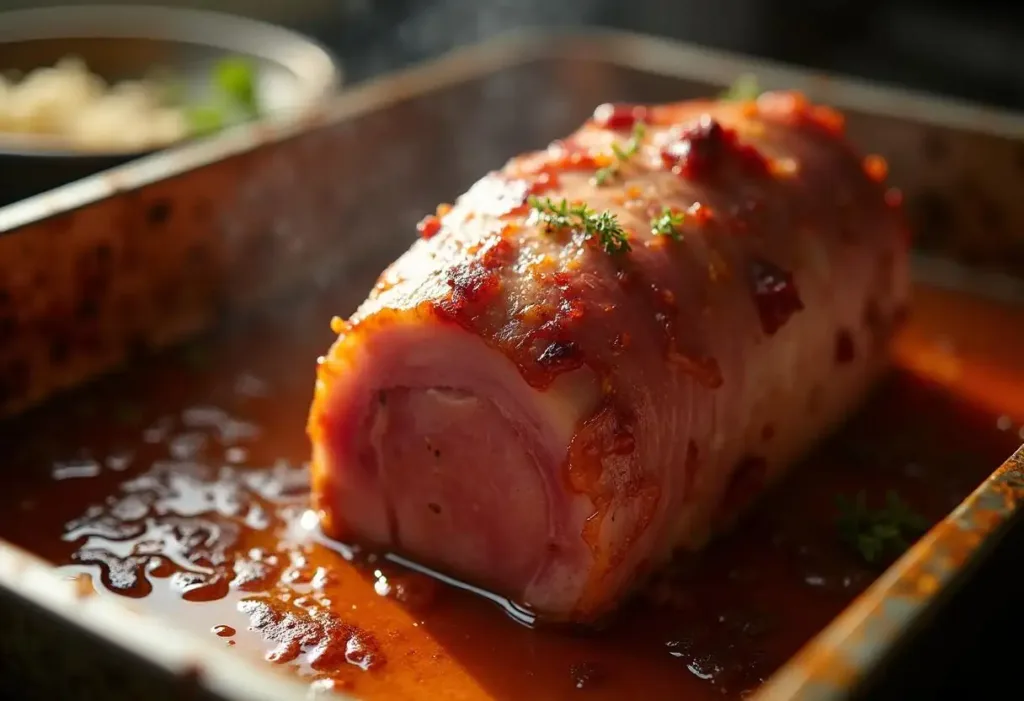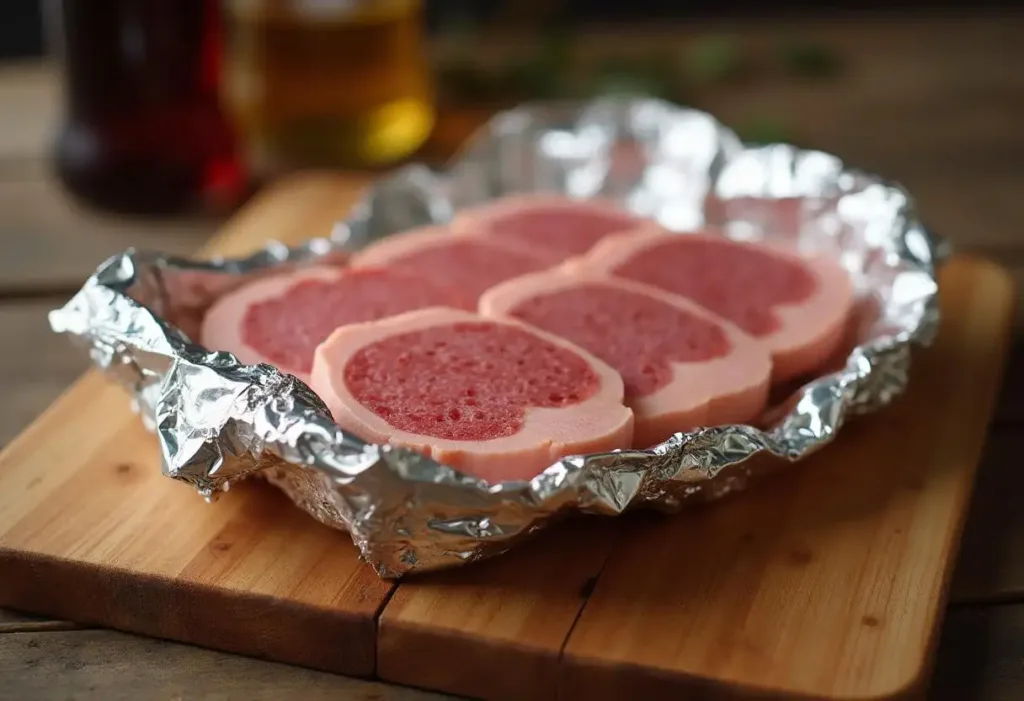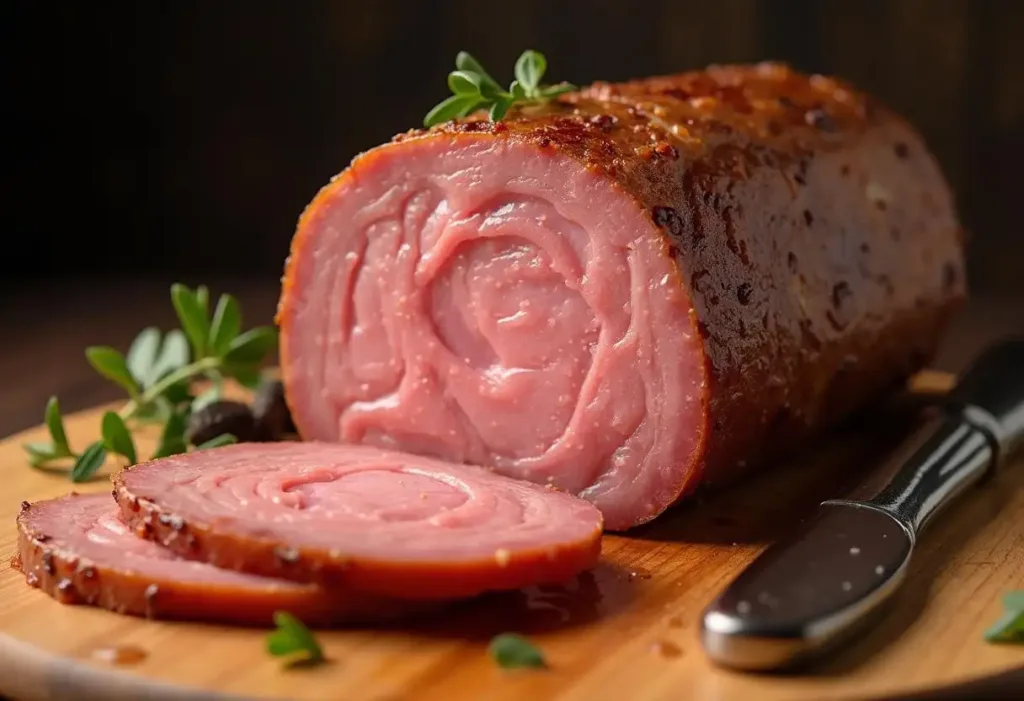Alright, confession time, amici. We’ve all been there, right? Staring at a gammon roast that looks… well, let’s just say more ‘Sahara desert’ than ‘succulent supper’. Mamma mia! I remember one Christmas dinner years ago, trying so hard to impress my in-laws, and my beautiful gammon came out drier than my husband’s terrible history puns. The disappointment is real, folks! Especially when you’ve got hungry mouths to feed, like my picky-eater son who eyes new foods with suspicion. Nobody wants dry, chewy gammon after putting in all that effort. So, the million-dollar question echoes in kitchens everywhere: How to Keep Gammon Moist When Roasting? It’s a totally valid worry! But guess what? You’ve landed in the right spot. Pour yourself something nice, and let this Italian-American mama spill all her secrets to juicy, flavor-packed gammon bliss.
I’m sharing my tried-and-true tips – the ones honed over years of cooking (and yes, a few early mishaps!) – to guarantee your next gammon roast is a showstopper. Get ready to wave goodbye to dryness forever! Juicy gammon is totally within reach, promise!
Understanding Gammon: Setting the Stage
Before We Roast: Gammon Basics
Okay, first things first. Before we dive into the juicy secrets of How to Keep Gammon Moist When Roasting, let’s do a quick Gammon 101. Nonna always said, “Understand your food, understand the flavor!” Simply put, gammon is a leg of ham that’s been cured – treated with salt (and sometimes sugar or spices) to preserve it and give it that signature savory taste we love. It’s essentially ham’s uncooked cousin. Knowing the crucial difference between gammon and roast ham is key: gammon needs cooking, ham is usually already cooked.
You’ll find gammon sold in different styles – smoked or unsmoked, bone-in or boneless. These differences can actually impact moisture! A joint with more fat or with the bone in tends to stay juicier than a very lean, boneless cut. Keep that in mind! Understanding the type of gammon you have helps you choose the best tactics for keeping it moist and delicious.
Want a broader overview of cooking methods beyond just roasting? This guide on how to cook gammon from BBC Good Food offers some great ideas, including slow cooking.
Pre-Roasting Prep: The Key to Success
Setting Up for Succulent Success: Pre-Roasting Tips
Alright, let’s talk prep! Because honestly, what you do before that gammon even sees the inside of your oven can make a HUGE difference in the juicy outcome. When you’re wondering how do you keep gammon moist when roasting?, these pre-game steps are your secret weapons. Let’s get that gammon ready for its delicious destiny!
To Boil or Not to Boil?
Ah, the age-old question! Should you give your gammon a hot bath before roasting? It’s a hot topic when discussing how do you keep gammon moist when roasting. Boiling can definitely help tenderize the meat and wash away some excess saltiness – great if you’re sensitive to salt or have a particularly salty joint. However, it’s not essential for moisture, and some folks (myself included, sometimes!) feel it can dilute the flavor. You can absolutely get juicy results without boiling. It really comes down to personal preference and the specific gammon you’re working with.
Still on the fence? We dive deeper into this very question right here, exploring whether you should boil gammon before roasting.
The Importance of Soaking (Maybe)
So, if you skip the boil, what about a soak? Soaking in cold water (for a few hours or overnight, changing the water periodically) is a gentler way to reduce saltiness. While it doesn’t directly add moisture like basting does later, managing the salt level helps the natural moisture shine through. Think of it this way: overly salty meat can taste drier. So, if you suspect your gammon is on the salty side, a soak is a good, optional step in your quest for figuring out how do you keep gammon moist when roasting. If you trust your gammon’s salt level, feel free to skip!
Room Temperature is Your Friend
Okay, this one’s non-negotiable in my book! Please, please, please take your gammon out of the fridge at least an hour before you plan to roast it. Putting ice-cold meat into a hot oven is a recipe for uneven cooking – the outside cooks way faster than the inside, leading to dryness. Letting it come to room temperature helps it cook more evenly, which is absolutely crucial when you’re figuring out how do you keep gammon moist when roasting. Think of it as letting your gammon gently wake up before its big oven debut. No cold shocks allowed!
Prep work done? Bellissimo! Now, let’s get to the main event – the roasting!
Roasting Techniques: The Art of Moisture
Roasting to Perfection: Essential Techniques
Alright, apron on, oven preheated – let’s roast this beauty! How you handle the actual roasting process is everything when it comes to answering how do you keep gammon moist when roasting. These aren’t complicated tricks, just simple techniques that make all the difference between dry and divine.
Low and Slow is the Way to Go
Forget blasting your gammon with high heat! Patience, my friends, is key. Roasting at a lower temperature – think around 320°F or 160°C – is the secret handshake for juicy meat. Why? Because it cooks the gammon gently and evenly. High heat cooks the outside way too fast, drying it out before the inside is even done. Low and slow allows the heat to penetrate gradually, rendering fat beautifully and keeping those precious juices locked inside. This is numero uno when you’re asking how do you keep gammon moist when roasting!
The Power of Basting
Think of basting as giving your gammon a regular little spa treatment while it roasts. It’s essential if you want maximum moisture and flavor! Every 20-30 minutes, grab that pan juice (or your glaze) and spoon it lovingly over the top of the gammon. This simple step does double duty: it keeps the surface from drying out and builds layers of delicious flavor. It’s a crucial part of the answer to how do you keep gammon moist when roasting. Plus, it helps develop that beautiful, glossy crust we all crave!
The Magic of Meat Thermometers
Okay, if you don’t have a meat thermometer, consider this your sign to get one! Seriously, it’s like a magic wand for perfect roasts. Guesswork is the enemy of juicy gammon! A thermometer tells you exactly when the inside has reached the perfect temperature – generally around 160°F (or 71°C) for gammon. This ensures it’s safely cooked through without being overcooked and dried out. No more sacrificing moisture for the sake of “just making sure it’s done.” It’s a small investment that pays off big time when solving how do you keep gammon moist when roasting!
Foil vs. No Foil: Wrapping It Up
To Wrap or Not to Wrap: The Foil Debate
Ah, the great foil debate! Should you swaddle your gammon in shiny armor while it roasts? This is another hot topic when you’re troubleshooting how do you keep gammon moist when roasting. Like boiling, there are pros and cons, and strong opinions on both sides!
Foil Wrapping Benefits
Team Foil has a point: wrapping the gammon, especially for the first part of cooking, creates a steamy little environment inside. This acts like a barrier, trapping moisture and essentially letting the gammon gently baste itself. The result? Often, incredibly tender, fall-apart meat. If maximum tenderness is your absolute top priority, wrapping can be a great strategy.
Foil Wrapping Drawbacks
But wait! That steamy environment has a downside. Foil prevents that glorious, golden-brown, slightly crispy crust from forming. You end up steaming the meat more than roasting it. If you love that caramelized exterior (and who doesn’t?), foil might be your foe. A common compromise? Wrap it for the first hour or two, then unwrap it for the last 30-60 minutes (especially when you add the glaze) to let it brown up. It also makes basting a bit trickier when it’s all wrapped up!
Post-Roasting Care: Keeping it Juicy
Post-Roast TLC: Locking in That Moisture
Okay, you did it! Your gammon is out of the oven, smelling incredible, looking gorgeous. High five! But hang on, don’t grab that carving knife just yet! This final step is CRUCIAL – maybe the most important piece of the puzzle for how do you keep gammon moist when roasting. You need to let it REST! Tent that beauty loosely with foil (yes, foil is good here!) and let it sit on the counter for at least 15-20 minutes, maybe even 30 for a really big joint. Why? When meat cooks, the juices get pushed towards the center. Resting allows those juices to relax and redistribute throughout the entire roast. If you carve too soon, all that lovely moisture pours out onto the cutting board. Sad! So please, be patient. Let it rest. It makes all the difference.
Ready to put all this juicy wisdom into practice? Give our foolproof gammon roast dinner recipe a try – it’s designed for perfectly moist and flavorful results!
Frequently Asked Questions (FAQ)
Q: How do you keep gammon from drying out in the oven?
A: The magic combo for keeping gammon moist is: roast it low and slow (around 320°F/160°C), baste it like crazy every 20-30 minutes, use a meat thermometer so you don’t overcook it (aim for 160°F/71°C), and MOST importantly, let it rest covered in foil for 15-20 minutes before carving! That’s the secret sauce for answering **how do you keep gammon moist when roasting**.
Q: Should you always boil gammon before roasting?
A: Nope, not always! Boiling is totally optional. It helps make it tender and less salty, but you *can* lose some flavor. Roasting directly can yield delicious results too. It depends on your preference and how salty your gammon is. Check out our thoughts on whether to boil gammon for more.
Q: What temperature should gammon be cooked at in the oven?
A: Low and slow is your friend! Aim for an oven temperature around 320°F (160°C). For the internal temperature of the gammon itself, use a meat thermometer and cook until it reaches 160°F (71°C) in the thickest part.
Q: Should I wrap gammon in foil?
A: Wrapping in foil helps trap moisture and makes the gammon super tender, but it stops it from getting that nice brown crust. It’s a trade-off! You can wrap it for part of the cooking time, then unwrap it to brown up at the end. Totally up to you and what you prefer!
Got those burning questions answered? Fantastico! Let’s wrap this up.
Conclusion
So there you have it, my friends! The secrets are spilled! Keeping gammon moist isn’t some mystical culinary art; it’s just about following a few simple, key steps. Remember: low and slow, baste like you mean it, trust your thermometer, and always let it rest. Nail those, and you’ve totally cracked the code on how do you keep gammon moist when roasting!
Now you can confidently roast a gammon that will make everyone at the table happy – even my picky son and chatterbox daughter give juicy gammon two thumbs up! Go forth, put these tips into action, and enjoy every succulent, flavorful bite. Don’t forget the perfect roast gammon sides to make it a complete feast! Let me know how your next roast turns out in the comments – I love hearing your success stories! Buon appetito!




